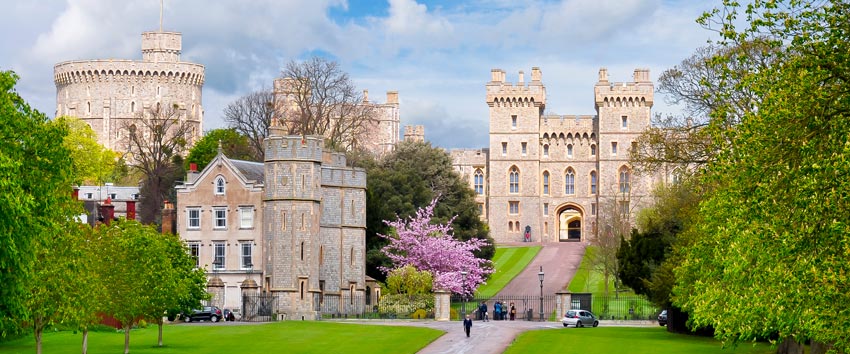Discover authentic England with a sojourn along the Great West Way. This ancient route is 125 miles long, reimagined, from London to Bristol. It roughly follows the Thames River and is home to three world heritage sites. This is slow travel at its finest—take your time to see the England you’re dreaming about.
Explore Windsor Castle, the oldest and largest inhabited castle in Europe. Visit Stonehenge, that mystical center, standing sentry in a vast plain for 5,000 years. Stop in Bath, an exquisite combination of Georgian neighborhoods, Roman ruins, and natural mineral springs. Bristol is cutting edge, and the Cotswolds are the cozy England of sweet villages.
Experiencing the Great West Way
London
Begin your travels in London, largest of the European capitals. Founded during the Roman era, it is one of the most diverse cities in the world. See Big Ben, the great clock at the palace of Westminster. Stop into Kew Gardens, a World Heritage Site in southwest London. Founded in 1759, it has the largest collection of botanicals in existence. There is also a plant DNA bank and 1.25 million specimens of fungus!
The treetop walkway opened in 2008. Walk under a canopy 60-feet above woodland glades. Plants from around the globe, with small structures that match their geo-location, is an unparalleled wonder.
Royal County of Berkshire
Continuing west, you arrive in the Royal County of Berkshire. This is where you’ll find Windsor Castle. There are picture-perfect villages and canal boats that ply the waters of the Thames. Consider a horse-drawn carriage. Delight in the waterfront shops and villages.
If you’re a fan of Downton Abbey, head to its film location, Highclere Castle. Afterward, challenge yourself with a walk through Longleat Hedge Maze, created with more than 16,000 English yew trees.
Arts & Culture
From London to the smallest village, the Great West Way has a healthy art and cultural scene. You’ll find century-old galleries cheek-and-jowl with pop-up art experiences in defunct red phone booths and sculptures hanging from trees. Internationally-known artists have moved here because of its inspirational beauty, and you’ll also find up-and-coming local artists.
There is glorious music, particularly in Bath. There are Shakespearean theaters, comedy clubs, experimental theaters, poetry readings, and book festivals. Check online and in local newspapers to find out what’s happening. New venues and artists are often a last-minute surprise!
Beautiful Vineyards, Breweries, and Bombay Gin
Wiltshire is foodie heaven and a feast for the senses. Beckett’s Vineyard produces sparkling wines and cider. Bluestone Vineyards shares its bedrock with Stonehenge. Wiltshire also has renowned breweries, including Wadworth, famous for its traditional brewing and shire horses, delivering beer to local pubs. Take a tour! You’ll find Stonehenge Ales at Netheravon as well as a number of other local breweries.
Only six vineyards in the UK have organic status, and Quoins Vineyard is one of them. Visit! On the borderlands of Wilsthire is the beautiful Bombay Sapphire Distillery—discover the magic that creates this beautiful gin.
Ancient Stonehenge, Avebury, and Salisbury
Stonehenge, older than the pyramids, is still a mystery. At various times it was thought to be a coronation place for Danish kings, a Druid temple, place of ancestor worship, and a healing center. Other than the Danish kings, probably all of these were true at one time. What we do know is that it was a prehistoric astronomical site that measured the movements of the sun and seasons, particularly those of the winter and summer solstices.
Stonehenge and nearby Avebury, plus other nearby prehistoric sites, all form a UNESCO World Heritage Site. Stonehenge is the most complex prehistoric site that we know about, certainly its stone circle is. Avebury is the largest site. Between them, there was over 2,000 years of monument building and use, occurring between 3700 BC and 1600 BC.
Cities, Towns, & Villages
The grand cities, quaint villages, towns, and ancient sites along the Great West Way tell England’s story. Visit Oxford. Classes have been taught at this university since 1096, and it has the largest press in the world. Its student body grew in 1167 when Henry II banned English students from studying in Paris. Twenty-eight prime ministers and 72 Nobel Prize laureates attended Oxford.
Also visit medieval Salisbury. This town of 40,000 people is easy to navigate. Just nine miles south of prehistoric Stonehenge, it is situated on the Salisbury Plain. Salisbury is known for its cathedral, considered by many to be the most magnificent structure in England. It has the highest spire, at 405 feet, and an original copy of the Magna Carta, signed in 1215 AD.
The small, typically English, villages on the Great West Way include Bradford on Avon, Chippenham, Hungerford, Eton, Henley-on-Thames, Winterbourne, Ascot, and Devizes—each has a unique feature that sets it apart from the others. Stop into a pub, chat with the locals, and enjoy great food.
Bath
Bath became a World Heritage Site in 1987, and it is known as one of the Great Spa Towns of Europe. It was here that early Britons built a shrine to their goddess, Sulis. The Romans came in 60 AD, turning the area into a spa town and dedicated the springs to their goddess, Minerva. They named the town Aquae Sulis, after the original goddess, and often traveled to Bath for renewal.
The temple and bathing complex was built over a period of 300 years in this sweet Valley of Avon. It was carefully engineered. The natural mineral spring was enclosed, and a building housed the hot bath, the warm bath, and the cold bath. Recently, 30,000 3rd century silver Roman coins were unearthed just several hundred feet from the entrance to the baths. Who stashed the money and had to flee? We’ll never know.
During the Georgian period, Bath was central to stylish England. The Royal Crescent and The Circus were built. Jane Austen lived here—walk in her footsteps. Bath has five theaters that attract well-known companies. Bath Abbey has 20 concerts each year. There is also the Mozartfest, International Music Festival, a film festival, Fringe Festival, Beer Festival and, no kidding, there is even a Chilli Festival. (They have their own way of spelling chili!)
Shopping
Along the Great West Way, you’ll find everything from kitsch to high-style. Look for independent boutiques selling sustainable fashion, vintage clothing, used book shops, antique shops, and local markets.
Bristol Blue Glass is a unique item to bring home, and shopping in the small store at Stonehenge is a must for memorabilia. Bath is a shopper’s heaven. Pick up one-of-a-kind jewelry from a local artisan. The Roman Baths also offer memorabilia. If you’re into clothes, stop in at Bath’s Fashion Museum.
Talk to locals for hidden gems. Many towns have small cottage industries that produce gorgeous ceramics, fabrics, clothing, and jewelry—you won’t find them online. There are craft collectives and pop-up shops; if you see something you love, grab it. The entire shop may be gone the next day.
Bristol
Bristol, the western end of the path, feels like an entire world away from London. It’s known for flamboyant street art—take a tour with a working artist. The harbor has dazzling walks, cafes, and views over the water. Consider a harbor boat trip for some of the finest views in the city. An engineering wonder, the Clifton suspension Bridge is a thrill. Go for it!
Bristol is one step ahead of everywhere else, has edgy art, and a heritage rooted in grand feats of engineering. Go on a hot air balloon ride, dive into the city’s experimental theater scene, and savor foodie heaven.
Living History
Just 125 miles along the Thames River, this slice of Southern England is a trip through living history. Trace the tales of England from Neolithic times to the present and notice how the river shaped the Way. Drive on one of King Charles I’s Great Roads built in the 17th century. Stroll on the Ridgeway National Trail or hop on the Victorian Great Western Railway. All give you a peek into the rich story of England, her hero’s, artists, inventors, and writers.
DOWNLOAD THE GREAT WEST WAY MAP
Be amazed by the England you discover on the Great West Way. Look for odd-ball attractions, eat at lovely cafes, discover artisan shops, and listen to exceptional concerts. Visit centuries-old tea rooms and forest cloaked in the mists of time. That there are three UNESCO World Heritage Sites along this short route is, in itself, stunning. An extraordinary adventure is the heart of your vacation on the Great West Way.



















